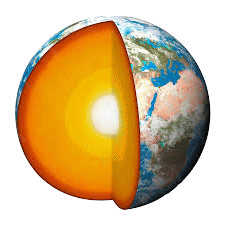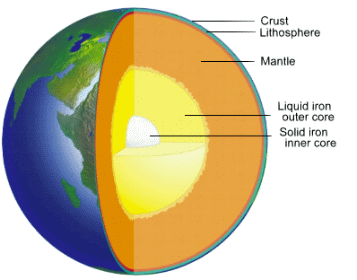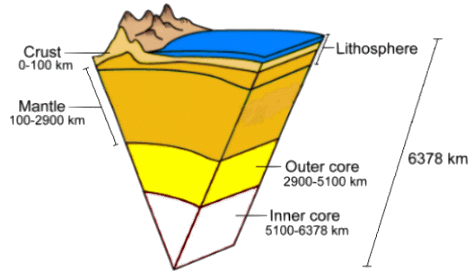  Scientists have discovered that earthquakes provides a picture of the inside of the Earth. After an earthquake, some underground shock waves arrive at measuring stations sooner than expected, based on their speed at the surface. These underground seismic waves change speed and direction just like ocean waves moving to shallow water, when they hit different layers within the Earth.
Scientists have discovered that earthquakes provides a picture of the inside of the Earth. After an earthquake, some underground shock waves arrive at measuring stations sooner than expected, based on their speed at the surface. These underground seismic waves change speed and direction just like ocean waves moving to shallow water, when they hit different layers within the Earth.This is because layers within the Earth are more or less dense than the layers around them. Seismic waves passing from one layer into another are refracted (bent) or reflected by different densities of materials, in the same way that light is bent or reflected when it hits something denser than air. You can work out the thickness and density of the layers from the amount of bending or reflection of the waves. Over the past century, we've learned that that the Earth's iside is madeup of layers, much like an onion. On the surface is the crust, which is fragmented in pieces that slide around on the mantle layer underneath. At the centre, getting progressively hotter, are the outer and inner cores. Let's look at these layers in more detail.    The crust is the rocky shell of the planet, and its thickness varies widely. Under the oceans, the crust is thinner – usually between 5 to 10 km, and made of denser rock like basalt. The crust of land masses can be a lot thicker, anywhere up to 100 km in mountainous regions, and made of a variety of lighter rock types.
The crust is the rocky shell of the planet, and its thickness varies widely. Under the oceans, the crust is thinner – usually between 5 to 10 km, and made of denser rock like basalt. The crust of land masses can be a lot thicker, anywhere up to 100 km in mountainous regions, and made of a variety of lighter rock types.Proportional to the size of the Earth, the crust is similar in thickness to the shell on a chicken egg. The crust represents less than 1% of the Earth’s volume. The upper mantle layer starts under the crust. It is mostly a mix of silica and magnesia, which together make up about 84% of the mantle’s mass. The parts of the mantle below 200 km are less rigid, and are at such high temperatures and pressures that they act like a very slow moving liquid. Because of this we have what are known as tectonic plates, big chunks of lithosphere that float on the upper mantle. These move about as the heat from lower layers shifts the mantle underneath in convection currents, in the same way that hot air in the atmosphere rises and gets distributed by the winds. In the process called plate tectonics, the surface of the planet is split into massive rocky ‘plates’ the size of continents. These move around as new rock from deep within the Earth is pushed up by convection currents, and pushes the sections of lithosphere over the mantle below. These processes are the main cause of earthquakes and volcanic activity, and have led to the growth of many of Earth’s largest mountain ranges. The lower mantle is made of similar stuff to the upper part; the top of the lower mantle is at about 1000°C, with the lower levels hitting as much as 4000°C. Like the upper mantle, the lower mantle is still essentially solid, but moves around less than the upper layer, mostly because of the extreme pressure it is under. The outer core is quite different. Unlike the fairly solid upper layers, it is a dense mixture of liquid iron and nickel, ranging from 4000 to 5700 degrees C in temperature. The movement of this thick layer of molten metal is thought to be a major factor in creating the Earth’s magnetic field. The inner core is also made up of nickel and iron, but is under such incredible pressure that it remains a solid lump, roughly 70% the diameter of the moon. The pressure of all the mass above raises the melting points of the metals, and forces them to stay as solids despite a temperature of more than 5400°C. |